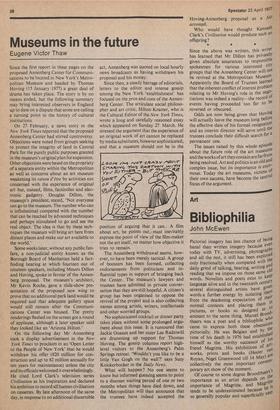Museums in the future
Eugene Victor Thaw
Since the first report in these pages on the proposed Annenberg Center for Communications to be located in New York's Metropolitan Museum and headed by Thomas Hoving (15 January 1977) a great deal of drama has taken place. The story is by no means ended, but the following summary may bring interested observers in England up to date on a dispute that some are calling a turning point in the history of cultural institutions.
On 27 February, a news story in the New York Times reported that the proposed Annenberg Center had stirred controversy. Objections were noted from groups seeking to protect the integrity of land in Central Park for the purely public purposes granted in the museum's original plan for expansion. Other objections were based on the propriety of a separate entity within the Metropolitan as well as concerns about an art museum weakening its raison d'être by activities not concerned with the experience of original art but, instead, films, facsimiles and electronic gadgetry. Douglas Dillon, the museuin's president, stated, 'Not everyone can go to the museum. The number who can is infinitesimal compared with the number that can be reached by advanced techniques and perhaps stimulated to go and see the real object. The idea is that by these techniques the museum will bring art here from distant places and make our art available to the world.'
Some weeks later, without any public fanfare, a non-judicial entity known as the Borough Board of Manhattan held a factfinding hearing at which fourteen out of nineteen speakers, including Messrs Dillon and Hoving, spoke in favour of the Annenberg proposal. The museum's architect, Mr Kevin Roche, gave a slide-show presentation of the proposed new wing to prove that no additional park land would be required and that adequate gallery space would still remain after the Communications Center was housed. The pretty renderings flashed on the screen got a round of applause, although a later speaker said they looked like an 'Arizona Hilton.'
On the following day Mr Annenberg took a display advertisement in the New York Times to proclaim in an 'Open Letter to the People of New York' that he would withdraw his offer (820 million for construction and up to 82 million annually for ten years for maintenance) unless the city and its officials welcomed it overwhelmingly. He cited Lord Clark's television series Civilisation as his inspiration and declared his ambition to record all human civilisation on cassettes. By late afternoon of the same day, in response to no additional discernible
act, Annenberg was quoted on local hourly news broadcasts as having withdrawn his proposal and his money.
Since then, a steady barrage of editorials, letters to the editor and intense gossip among the New York 'establishment' has focused on the pros and cons of the Annenberg Center. The articulate social philosopher and art critic, Hilton Kramer, who is the Cultural Editor of the New York Times, wrote a long and carefully reasoned essay which appeared on Sunday 27 March. He stressed the argument that the experience of an original work of art cannot be replaced by media substitutes, however sophisticated, and that a museum should not be in the
position of arguing that it can.. A film about art, he points out, I must inevitably express the point of view of the film-maker not the art itself, no matter how objective it tries to remain.
The Annenberg withdrawal seems, however, to have been merely tactical. A group of boosters has been formed, collecting endorsements from politicians and influential types in support of bringing back the Center. The museum's lawyers and trustees have admitted in private conversation that they are still hopeful. A citizen's group has been organised to oppose the revival of the project and is also collecting names among artists, writers, intellectuals and other worried groups.
No sophisticated cocktail or dinner party takes place without some prolonged argument about this issue. It is rumoured that Jackie Onassis and her sister Lee Radziwill are drumming up support for Thomas Hoving. The gossip columns report highlevel visitors to the Annenberg's Palm Springs retreat. 'Wouldn't you like to be a little Van Gogh on the wall?' says Suzy Knickerbocker in the Daily News.
What will happen ? No one seems to know but informed guessing seems to point to a discreet waiting period of one or two months when things have died down, and the Metropolitan will then announce that the trustees have indeed accepted the
Hovirig-Annenberg proposal as a fait accompli. Who would have thought Kenneth Clark's Civilisation would produce such an offspring?
Since the above was written, this writer has learned that Mr Dillon has privatetY given absolute assurances to responsible spokesmen for various interested city groups that the Annenberg Center will not be revived at the Metropolitan Museurn. Apparently the Board of Trustees learned that the inherent conflict of interest problem relating to Mr Hoving's role in the negonations was indeed a reality—the record of events having proceeded too far to he reversed. or obscured. Odds are now being given that Hoving will actually leave the museum long before the effective date of his formal resignation and an interim director will serve until the trustees conclude their difficult search for a permanent one. The issues raised by this whole episode about the future role of the art museums and the works of art they contain are far from being resolved. Art and politics is an old and complex issue, but its importance is enor: mous. Today the art museums, victims ot their own success, have become the central focus of the argument.


































 Previous page
Previous page